Archive for the ‘Uncategorized’ Category
MELBOURNE AND NEW CALEDONIA

The red arrow points to Sydney, Australia
MELBOURNE
As previously described, I arrived in Sydney after flying many hours through several time zones. Phone calls to friends in Melbourne were successful, so I hopped on a TAA flight to Melbourne, arriving there in the late afternoon. I was dead on my feet, so quickly found a hotel and went to bed. It was Saturday night. I awoke in the wee hours of Sunday, ravenously hungry, to find that on Sunday Melbourne does not wake up. There was nothing to eat at the hotel (no room service, not even a “Mr. Coffee” (it had not been invented yet) in the room. I slept fitfully and finally got up and out around ten: there wasn’t a soul stirring anywhere, everything was closed. I wandered around aimlessly, but suddenly heard the unmistakable rumble of a street-car. Following the sound, I spotted a lovely MMTB “M” and decided to take a ride—I didn’t care where it went. Now, I don’t remember where it went, except that somewhere along the way I spotted a cafe that was open and I managed to get some food.

The red arrow points to Melbourne

The luggage tag on my bag full of dirty clothes

Style “M” tram crossing the main drag

MTB trams used a zone system
My friends picked me up at my hotel that afternoon and we went to their home in the outskirts: we used the wonderful interurban system, and while at Flinders Station I spotted some wonderful old red cars. I simply had to ride in these the next day, and wound up at St. Kilda Beach.

Great old electric train-sets still running
Soon to be retired, however.

Another panorama shot, repaired
St. Kilda Beach, Melbourne
To say that I was underwhelmed by Melbourne is an overstatement, and the prospect of working there for any length of time really did not appeal. In particular, the lack of ethnic diversity struck me forcibly, since I had just spent over 10 months in and around SEA. Melbourne was distressingly “white”. But my friends felt they really needed my expertise on the Bay Project, so they wined-and dined me, took me to a game preserve to meet some unusual critters, and did their best to make me feel at home. But it didn’t work, and after just a few days I was anxious to move on. The itinerary I planned called for stops in New Caledonia, Fiji, Tahiti, American Samoa, Western Samoa and Hawaii, arriving back in the states in time for Christmas.
I returned to Sydney, once again simply transiting and changing planes. Before long, I was in Noumea, Capital city of New Caledonia.

Transport to TAA

Off to New Caledonia
Noumea, 4 December 1968
Dear all~
Well, after spending nearly 11 months in South-East Asia, I find I am experiencing “withdrawal symptoms”, or perhaps one could say I an SEA-sick. In any event, I find I miss the calm and ingenuousness of the people [there].
Without quite realizing it ’till I got there, I wound up in Melbourne as far south of the equator as San Francisco is north of it (well below the Tropic of Capricorn even), so the weather was much the same as SF right now, except that summer is approaching in MB while winter lies ahead for SF. Through the good offices of Don & Marian, we went on Sunday to Healesville Animal Preserve, which is an elaborate sort of zoo with at least as many beautiful beasts on the outside of the cages as on the inside. Because of good weather, the place was crowded with people, and the kangaroos were so sated with hand-outs all they could do was lie in the sun & let the children maul them! Emus wander about the place in numbers. A nice feature of the place is its huge walk-through bird-cages where you are inside the cages with the birds. Got to see a lot of animals I’d never seen before, and they even have a platypus on display—quite difficult to achieve because the platypus is extremely sensitive to humans—and a lyre-bird pair and chick, though my only view of the he-lyre-bird was at a great distance as these birds are even more shy than the platypus.

I don’t remember what this was

Unusual beasts: echidnas

There’s a Koala in that tree

A Wallaby. Looks like a good pet
On Monday (2nd Dec) Don & I conferred with various departments of the MMBW (Melbourne & Metropolitan Board of Works) on aspects of the Environmental Study of Port Phillip Bay, to which I would be assigned if I decide to return to do so. Although Australia is about the last place on my list of choices to work, a temporary assignment of 6 to 8 months might not be too bad (starting in January the weather gets very warm). Melbourne itself is a huge metropolis—actually, it is nearly all suburbs—with some good points: the architecture is very victorian, they have a good street-railway and an excellent (but ancient!) interurban train system. The cost of living is surprisingly low, roads are excellent, and there are lots of interesting places to go in the interior: gold-rush towns, etc., etc. But the population is so bloody white and all the customs so british! Movies, including those shown on TV, get a censorship-board rating (inexplicably, “Star” gets an “AO”=Adults Only rating!) which (on TV) is superimposed over the title at the beginning so one can hustle the kiddies off to bed before settling down to an evening of surreptitious thrills. Except for a few (visiting) Asians, people of color are rigidly excluded from Australia, so one has to get used to seeing the uniformly sickly pallor typical of the english (“slug” as Stephen Potter would say). As for my working for the MMBW, they seem quite agreeable, and I did file an application, but the decision awaits further investigation of alternatives by me, and frankly I hope some better alternative presents itself!

Luggage tag to Noumea
Tuesday morning I took a TAA flight to Sydney, where rains have extinguished most of the brush-fires, and on to Noumea. New Caledonia is a curious island, being just a cigar-shaped mountain-range about 250 miles N-S and +/- 30 mi E-W. The west coast is quite un-tropical and very dry; the predominate tree is a variety of eucalyptus, which burns well—there are several fires burning here, too—in fact one just up the little hill behind my hotel which broke out a few moments ago. The east coast, where all the rain falls, is said to be typically tropical, and I hope to go over there tomorrow. It is colorful here, though—frangipani, and some sort of flowering tree [Poinciana] is brilliant orange here, and bougainvillea are everywhere and very beautiful. The town shuts down from 11:15 to around 3 PM. I will take in the aquarium this afternoon, and I swam at Anse Vata [beach] this morning. Just around Noumea alone there are a dozen or so good beaches, and of course there’s 500-600 miles of shoreline all dotted with them. Noumea “dies” completely on weekends, though; nothing is open. So Friday morning I depart for Fiji where I hope the same is not true. I hear that Tahiti is so commercialized now it is hardly any fun—so I may decide to go to Tonga instead,and fly home direct from Samoa. Or I may go to both places for briefer stays. Don’t know yet—will wait and see what I learn in Fiji.

The red arrow points to Noumea on New Caledonia
[Later]
The aquarium is, as all the pamphlets say, small: but oh, my what gorgeous things they have! The fish, and more especially all the other animals they have on display (corals, sponges, anemones and so on) are just not to be believed. The owners and developers of the aquarium (it is privately owned) discovered some years ago the “luminescent” (i.e., fluorescent) corals that glow under UV light, and have what is claimed to be the only display of them in the world. They glow only if they are alive, so the dozen or so tanks they have devoted to these are really fascinating, and unimaginably beautiful.

Typical tank in the Aquarium in Noumea
Australia, has, incidentally “ATV”, a single government-run non-commercial station. On it [while in Melbourne] I saw an excellent documentary called, appropriately enough, “Toward Tomorrow”: it is about C-B-R warfare, and shows in actual photos how far along we and particularly England are with this charming branch of study. Man’s capacity for evil may be exceeded only by his lack of judgement; in any case, the research in this area is a multi-million dollar investment already (cf. previous letters, this topic) as the movie more than adequately shows. Shown also is the lack of judgement, so evident in many of the interviews with people involved in the work. The american viewpoint is lengthily discussed by some Major-General whose appearance (and most of his pronouncements) is almost imbecilic. While one or two of the workers lament their involvement in what is obviously an offensive job, none appear to have enough strength of conviction to get out and find a less offensive job; one wonders what fascination compels them to remain? The most pathetic to me was one “scientist” whose only excuse was that he felt the “quality” of the work being done (in england) was “very high”. The fact remains that biological warfare a) is already in use (in VN and apparently in Yemen); b) is capable of mass demolition of humanity that makes Hitler’s pogroms look like child’s play; and c) is contemplated by military authorities with no less enthusiasm than other currently “conventional” methods of destroying adversaries. KQED might get hold of this film—I hope—but if you get to see it, take tranquilizers first. It is one of the most unpleasant things I’ve seen in years.
05 December 1968
Alas, the east coast will have to wait—the local transportation is not good enough to make a one-day return trip to “the other side”. Another time, perhaps. Instead, I shall take a boat ride this afternoon to the 100 year-old light house, on an island off-shore a ways, and see what else there might be to do there. I depart for Fiji at 7:15 AM (!!) tomorrow.
I took a few photos in Noumea, but in the main I was not impressed with the place.

Noumea was a deep-water port

Anse Vata beach near Noumea

There was a fire on the hill behind my hotel

Noumea was nothing if not colorful!

The flame trees were spectacular
My letter continues on the next page, as I move on to Fiji.

NEXT
I PUT DOWN ROOTS
I returned from Australia mid-1970, somewhat foot-loose. I bought a single-cylinder BMW “thumper” to get around on, and did some odd jobs for friends to earn a few pennies. As summer approached, my brother Todd asked me to look after his studio in the Sierra foothills while he scoped out prospects for summer art sales in Alaska. I spent the summer months in Sutter Creek; where Melbourne had been dull, SC was utterly dead (at least for a young gay guy like me). I often drove all the way down to West Sacramento, where there was a sort of tubs I thought might provide some relief, but I don’t recall ever actually finding a trick there.
To keep busy, I undertook some repairs on the facade of my brother’s little shop. One day as I worked at this a tall, lanky blond youngster wandered along looking for work. I hired him to assist, but could not resist putting the make on him during lunch. Typically of my luck, he said he wasn’t interested, and at the end of the day’s work, I paid him off and he disappeared.
The very next morning I was seated at the little desk in the shop when a police car drove up and parked in front of the shop. A uniformed officer got out of the car and came into the shop:
“Are you Mr. Bramson?” he asked.
Of course my mind ran wild: that blond kid must have blabbed, and now I’m in deeeep do-do!
“That’s me.”
“Your friend Ronnie in San Francisco called and asked us to give you a message — he’s forgotten your telephone number. He’d like you to give him a call.” The officer departed, and I heaved a great sigh of relief! The blond must have just been “passing through” — I never saw him again.
I PUT DOWN ROOTS
Late that summer I rode my little thumper down to San Francisco intent on staying with friends and spending a few nights at the tubs. By chance, I drove by the old house my Ex and I had owned, and noticed it was for sale. Now, I had always loved that house: that it held some unpleasant memories was not it’s fault, and I thought if I bought it by myself for myself, I could expunge the bad memories and have a nice hobby and a roof over my head as well.

Built in 1889
However, I had very little money and no job, so buying a house seemed out of the question. The more I thought about it, though, the more I realized I wanted that house. I called the realtor, learned the price and terms and explained that I “had no money and no job, but I’ll get back to you.” I then called my old employer: did they have a job for me? “Can you start Tuesday?” was the response. Then I called my brothers, parents, and friends: before long I had commitments sufficient for a down-payment, so I called the realtor back. “I now have a job, I have some money, so I’m ready to make an offer.”
The long and short of it is that after some negotiations, my offer was accepted, based on giving the owners 90 days to vacate.
Meanwhile, through friends, I happened to meet the fellow who had been my immediate predecessor in my Ex’s life—and we found we had much in common. Learning that Johnnie had nearly driven Ted insane came as no surprise: he drove me nuts as well. So I moved into Ted’s house temporarily, until “The Mansion” was cleared out and I could reside in it.
My Ex, you may recall, had made arrangements to sell the house without telling me, so it was imperative that he get a quit-claim for my portion of it. This he got at knife-point, and the rest is history. Since 1964 the house had been occupied by a religious cult that took guys off the drug trip and put them on the God trip. (Out of the frying pan into the fire as far as I’m concerned.) Nevertheless, I knew from a member of the Board of Directors that the building had not been severely trashed, although there were 53 people living in it. This is how I knew they would not be able to vacate in the usual 30 days. Since I was in no hurry, I applied myself to my job again, built up my bank account, and waited.
The house was still not vacant at 90 days, so I informed the occupants they would have to pay rent; they did so for two more months before, finally, in May of 1971, the deal closed and I took possession of the building in which I still reside. I’m still renovating it, though it is in much better shape now than I am!
With all the current flap about toxic mortgages, I find it interesting that I got the house with just over 10% down. But the interest rate on the first mortgage was 18.5%, and on the second mortgage 25%! For the first year I occupied the house, I watched my equity “build” at literally pennies per month!
My house has been a very important part of my life for almost 40 years. I have zillions of photos showing the many renovations that have taken place over the years. I’ll try not to bore my readers with too many of these, focusing instead on other aspects of my life – my travels to distant places and so forth.

40 guys lived here!
There were several projects over the years of considerable magnitude. The first was to replace the roof, which leaked badly. This occurred in 1975, when a second re-finance brought forth the necessary funds. The most expensive part of the job was removal of the old roof, consisting of 4 and in some spots 5 layers of “modern” material over the original wood shingles. To save money, I did the removal myself, aided by a gaggle of Ted’s students. Ultimately, we removed and disposed of 9.5 tons of old roof! Among the interesting findings were burned portions of the spaced sheathing on the north slope of the roof: the 1906 fire burned itself out just half a block away, but clearly owners of my house had managed to put out “hot spots” and saved the Mansion from joining the thousands of others destroyed.
Another problem discovered was that the South stub-wall had shifted out of line rather noticeably, probably in the 1906 earthquake. I did not want to leave it so. When all the weight was off the roof, I used a 12-ton come-along to pull the wall back to plumb, assisted by jacks forcing the ridge-pole up. When all was aligned, two hefty membranes were added to lock the walls in place, and the rafters were further locked with tensioners that had not been installed previously.
Here’s a series of photos, from start to finish, of the first roof replacement during my tenure (it has now been done again):

Once a little area was cleared, the spaced sheathing acted as a ladder, and I could work comfortably. I always used a harness to prevent falling, however!

All the detritus was forced through the spaces onto the attic floor.

We rigged a block & tackle to an old fire-escape, and the trash was sent down to ground-level one garbage-can at a time.

At ground level the trash was put into a wheel-barrow and taken to the front of the house.

The junk was stuffed into an old hulk of a VW camper. In a day I could clear, and the guys could load, one camper-full.

Plywood sheathing was pulled up from below one sheet at at time and stacked in the attic. From there it was maneuvered into position on the roof and nailed down.

With weight off the roof, I used a come-along to pull the south stub-wall into place, assisted by jacks pushing up on the ridgepole.

There were other things to attend to, like repointing a chimney.

The 3/8″ plywood gave a better base than the spaced sheathing for the new roof of composition glass, tar and stone

Here I’m adding a skylight, without which the attic is rather dark.

After all the preparation was done, the professionals moved in! Here is their A-frame used to haul up bundles of roofing material.

All the new material was hauled up and distributed to workers.

It was a long way down to the street!

Growl! Musta been a tough day up on da roof.

It was one of the filthiest jobs I ever did!
It took me six weeks to clear the old roof, install the new plywood, and do most of the flashing. It then took the professionals less than a week to install the new 25-year roof. It actually lasted far beyond its guarantee, and never leaked. Nevertheless, in 2008 this roof was removed down to the plywood, and a new 40-year roof was installed. This time I let others do the whole job!
Another big project will be described here soon.

NEXT
COMING OUT TO FAMILY
MILITARY SERVICE?
Through all the convolutions of my life to the point described so far, there was the threat of military service: the draft was in effect. While my frequent contacts with the Navy had all been great fun, I was quite certain I would not survive basic training or anything else. As a confirmed pacifist who hated guns in any form, to me the idea of operating one was hateful, and the notion of using one to kill was beyond the pale. So I was well pleased when, after the first physical exam, I was rejected—for 6 months! Back again after that period, I was again rejected—for a year!
I felt certain the third time would get me into the Army, so I tried out for the Coast Guard, and was accepted for Officer Training School. I knew a chap who had done this, and he said it was an OK kind of thing. However, before I could actually sign on the dotted line with the Guard, I was rejected—permanently—by the Army. Whoooopeeee! Four-Eff! Never was I so happy to be rejected! Without the threat of service hanging over me, I could get on with my life.
BY THE WAY:
I watched President Obama’s 100th-day news conference. I came away more glad than ever that we elected him. After eight years of the kind of inane blather that was all Dubya could muster, to watch and listen to someone who can organize his thoughts, express them cogently, with dignity, and occasionally with humor is wonderful! He can even pronounce NEW-KLEE-ARE!! Whoopee!
OK, ON WITH COMING OUT: MY FIRST HUSBAND
There came the fateful night when I went back to the john at the Crystal to let some of the beer run out. There I met Johnny, a handsome black boy a few years older than I. Word had gotten out that the Crystal in San Jose was more fun than any of the gay bars going in San Francisco, so we would get a few car-loads of guys down from the City on weekends. So it was that Johnny had joined some friends, telling them as they drove down he intended to find a boyfriend that very night. He found me. He introduced me to his friends, then we repaired to my apartment and got to know each other quickly.
But I was young and impressionable, and Johnny said all the right things, did all the right things and soon had me wrapped around his finger (when I wasn’t wrapped around his cock). He courted me in San Jose for several weeks, driving down after school: he was a teacher, so out of the classroom by 3:30 or so. I was working 5- 8s, so by the time I got home he was there waiting. It was wonderful: I was in love again.
He soon persuaded me to move in with him in San Francisco. He already had a room-mate, a rather strange fellow named Sid, who was soon jettisoned to make room for me. The honeymoon lasted some months, but clouds developed before long. I soon figured out Johnny was a lush—badly addicted to alcohol—which was a problem I had never dealt with. Worse, he was not a happy drunk: quite the opposite, he got belligerent and then morose as he drank. For the better part of two years I held on, hoping there would be some change, and eventually a change did take place: we pooled our resources and bought a small Victorian house to fix up. This worked for a while: Johnny stayed somewhat more sober than usual in order to be able to help with the renovation.
In 1963, with the house in pretty good shape, we spent a summer in Europe. In those days black guys were much less commonplace in Europe, so he was very much “in demand”. I, on the other hand, believed strongly in a monogamous relationship. Soon we were both “playing around”, separately, and the relationship took a back seat.
I did, however, notice how many old people from America were in Europe, being herded around like cattle. We made up our itinerary as we went along, seeing whatever we wanted to see, but the tourists saw what the tour-guides wanted them to see. I thought it would be horrible to travel in old age, and made up my mind to see more of the world when I was young enough to enjoy it.
Once back in the USA, our relationship took a rapid nose-dive. Johnny’s heavy drinking resulted in his having badly flavored semen, so I was becoming less enthusiastic about sucking him off. This frustrated him, which led to more drinking. It became clear that he had a deep-seated resentment of being gay: though that was not my fault, he took it out on me, and there were many long arguments, recriminations and bitching at each other. Through it all, he remained almost perpetually inebriated, only managing to keep his job with some difficulty. We stopped sleeping together, and I spent a good deal of time in the tubs, often staying away from the house for several days at a time.
Then, in 1964, Johnny discovered drugs. While I was sucking dick in the tubs, he was up in the Haight-Ashbury doing drugs. When, after a knock-down drag-out argument one night he went after me with a kitchen knife, I knew it was time to split.
The divorce was messy! I signed a quit-claim deed on the house, and Johnny sold it within a few days: seems he had a buyer all lined up. I got nothing, except my freedom, but the price was worth it. Johnny went through the $40,000 in a couple of years, buying booze and drugs. I’ve never seen him again. I never got to thank him for destroying my love for him before we parted: otherwise, it would have been tough, but as it was, I was delighted to be footloose and fancy-free once again.
Coming soon: the family finds out about me.

NEXT
TONGA

The red arrow points to Tonga
From Suva, there was a short bus-ride to the airport. I’d been told this would cost 50p, so I held on to some pocket-change. But there was one chap in our small group bound for Tonga who had depleted his local money: I bought his ticket for him, and we thus struck up a brief friendship as travelers often do. His name was Peter Salisbury, from Australia, and our respective itineraries were the same for a few days. I eventually deduced he was spending his inheritance on a round-the-world trip; a genuinely friendly chap, he was a trifle disorganized. In Tonga he stayed at the Intercontinental, but I booked the “bunkhouse” a bit further along the main street. Both were very close to the water, where there was a bit of beach, and many youngsters swimming, often nude. They were so cute: one hated to think of them grown up into multi-hundred-pound behemoths.

I love to watch kids frolicking in water

The guy in the white shirt ignores the kids
Since I was the only person Peter knew on the island, and vice versa, we hung out together a good deal. Peter often invited me to share the entertainment at the Intercontinental, mostly dancers, fire-breathers, and so on. Some of the guys were breathtakingly handsome, not yet having built up the excess avoirdupois that tends to characterize men there. I was particularly struck by the variety of ways the guys wrapped a lava-lava around themselves, and the speed with which it was accomplished: beginning with a simple strip of cloth, it could be fashioned into a crotch-hugging “bathing-suit” in a trice. Alas, they all had on skimpy posing-straps to keep the family jewels from showing. Damn!
One day Peter told me he’d arranged for a luau for the two of us; he introduced me to the local fellow setting this up, and my gaydar went to the pin. Not that he was attractive: too much adipose-tissue for my taste. I was pretty sure Peter was not gay (my gaydar stayed at zero around him), so I was not sure how all this was going to work out. The luau itself was entertaining and the food was excellent, but there was a lot more beer than was necessary to wash it down: I took it easy but Peter did not, and when he was pretty well sloshed, our host(ess) pounced: Peter freaked out! The luau was suddenly over! Thank gawd the host(ess) didn’t want me. Later that night, with Peter tucked safely away in his expensive hotel, I met a much nicer local chap as I was was walking back to the Bunkhouse: we repaired to one of those elevated houses the Tongans favor, and with his brother, the three of us had a grand romp!
Peter recovered, and the next day hired a local chap with a boat to take up out to a little island a bit off-shore. He had lunches packed at the hotel, and we went for a day’s outing—swimming, beach-combing, and so forth. There were two problems: the island was tiny, we could walk right around it in ten minutes, and there was not much of a beach. Nevertheless we managed to while away most of the day, until the skipper indicated it was time to head in—clouds were gathering. Of course, he could read the weather and the water, but we could not. By the time we got our act together, the wind was up, the water was choppy, and there were the three of us in this tiny dinghy with an ancient put-put motor heading for the home shore. Water broke over the bow, we got soaked, and all I could say to myself over and over was, “The Tongans populated the whole South-Pacific by boat: we must be safe in this guy’s hands”. We were safe, as it turned out, but got to shore bedraggled and happy not to have drowned!
Nuku’Alofa, Tonga
13 December 1968
Dear Everybody~
Here beginneth the final epistle in this, the second phase of my 1968 pilgrimage; any letters I were to write following this would probably get home after I do. Such is the way when one flies, these days!
On my last day in Nadi I took another boat trip, mainly for coral-viewing. I did no swimming, as I was still smarting a bit from over-exposure the day or two before. But it was a relaxing half-day trip—all of four people aboard! Then on Tuesday, at the unholy hour of 6 AM, I boarded a DC-3 Fiji Airways plane for the flight to Suva. Egad! How small the plane seemed! My last ride in a DC-3 was in the passionate-pink “Standard Airways” flight Oakland to Burbank in 1963, the first leg of the infamous Terry Davis debacle. Of course, the seating is really superior to (tourist sections) of the larger jets, and visibility from the air—it did get off the ground, and with less effort than I’d remembered—is better as well.
Now, Suva is on the “wet” side of the island of the Fiji group (there are 300-odd in the group), and the contrast is quite remarkable. The dry side, which has low coastal plains (given almost entirely to culture of sugar cane) rises quickly into dry, California-like mountains—forest fires here, too. The whole South Pacific has been unseasonably dry for about the last 6 weeks; water shortages are common. Even so, Suva is conspicuously more moist, with lots of lush growth, beautiful flowers, wild fruit, etc., etc. The town itself is quite a small & quiet place. I took a car tour here in order to make the best of the one day I had; then yesterday, also very early, boarded a Hawker-Siddeley 748 Prop-jet for the approx. 2 hr flight to Tonga. We landed, to my surprise, on a grass air-strip; there was a big crowd because the King & Queen were on their way out on the return flight, and were indeed present & waiting. We then proceeded to cross the whole island in less than 15 minutes to Tuku’Alofa (sic) the capitol city. Now, I’d been led to believe Tonga was quite a prosperous place, but it seems not to be so. However, there is oil here, and that is under investigation for development, which could transform the island practically overnight. There is one Intercontinental Hotel with appallingly stiff tariffs, and one “bunkhouse” in which I am lodged at less steep but still too high rates. There is, essentially, nothing to do, which is just fine with me as I anticipate a pretty hectic time when I get back, and need some good, deep relaxation just now. A group of us may take bicycle rides around the island tomorrow, but otherwise it will be just lolligagging, swimming (fair beach here) and eating & sleeping. It looks as though three days in Apia (W. Samoa) and 1 or less in Pago Pago will complete the whole shebang—and certainly will exhaust my current supply of funds! The flight to Apia (DC-3, maybe 4) is “scheduled” for 11:15 Monday, but we are told it may go anytime thereafter, surely not before! Polynesian Airways obviously is run the polynesian way, which is, to put it the nicest way, “relaxed”.
So, I shall be seeing everyone quite soon—I hope this letter gets there before I do—and of course I look forward to at least the brief visit I shall have on the mainland.
Luv to all~
Bruce

The plane which delivered us to Tonga

Home of the King & Queen of Tonga

There really wasn’t much to Nuku’Alofa

A long-wharf at Tonga
 Beautiful sky over boats at Tonga
Beautiful sky over boats at Tonga 
The bunkhouse was just across the road from the ocean

Rather staid currency from Tonga

The backsides were more colorful
I was unable to find any crisp clean ones!
Further adventures awaited me in Western Samoa, although an unscheduled stop in Pago Pago was amusing. Coming up!

NEXT
WESTERN SAMOA, PAGO PAGO, AND HOME

The red arrow points to American Samoa
From Tonga I was booked to fly to Western Samoa: Peter was on the same DC-4, with just a few others. However, when we landed, we were in Pago Pago (American Samoa). It seems the Micronesian Airways plane needed fuel, which was cheaper there than in W.Samoa. It further devolved that there were many passengers wishing to fly from PP to W. Samoa, so Micronesian Airways accommodated. We disembarked while the refueling took place, and when we re-boarded, the plane was full—every seat taken. Most of the passengers were women, on their way (I learned later) to a temperance meeting in W. Samoa. We seemed ready for takeoff, but the door was opened again, a man came in, went to the front and addressed us all in Samoan: there was a bit of discussion, and several ladies disembarked and we were on our way soon thereafter.
It’s a short flight to W. Samoa; once again we landed on a grass strip. The “airport” was a steel shed, and a bus awaited everyone for the trip to Apia. I found myself sitting next to the airplane’s Captain, so asked him what the reason was for the passengers who were left behind in Pago Pago: his answer amused me. Having taken on fuel, when loaded with all the ladies (most of them tres corpulent) the plane was overweight for landing successfully at W. Samoa’s grass field! To make the weight limit, they had jettisoned several passengers.

This was the event all the women flew in for
It is 30 miles or so to Apia, and one of the first things one passes after leaving the “airport” is the wreckage of a plane that didn’t quite make it: the Micronesian Airways logo was still visible, which gave us a lot of confidence! Nevertheless, we had made it to W. Samoa, so presumably we would make it back to Pago Pago in a few days.

What is that huge cathedral doing there?
The chief glory of Apia, besides a surprising number of christian churches (which somehow seem very out-of-place) is something called the Palolo Deep. This is a deep hole off-shore some distance but within a reef: one is safe snorkeling or diving there from predators—sharks in particular. One walks out on the reef, wearing foot-protection, in water up to your knees until standing right on the edge of the hole. Because of the air-water interface, nothing can be seen in the water, which appears black. But the instant one puts on a mask and gets even just that below the surface, a whole new world opens up.

The bright blue patch surrounded by coral is the Palolo Deep

A better view of the Palolo Deep
I managed to find a snorkel that was long enough to overcome my tendency to sink, and spent a number of hours out there over several days. It was spectacular, and after I developed the sense to wear a tee-shirt to protect my back from the sun, I enjoyed snorkeling a lot. Fish, large and small, of all sorts and colors are there and have to some extent become inured to the presence of people: they come right up and peer at you from just inches away!
Peter also did some snorkeling, but ignored the warning to wear something on his feet, so he got serious cuts and infections which (I heard later) landed him in the hospital when he reached the US. There were signs everywhere warning of the danger of walking on coral; the ramshackle bunkhouse inn I stayed in had a huge pile of old sneakers there for the taking, as long as they were returned for someone else to use later. I used them always, and had no problems.

I had very little of this left over

The $2 bill was more colorful
However, there was not a whole lot of anything else to do in Apia, so I moved on after just three days. Peter remained there, and I never saw him again. The flight back to Pago Pago was uneventful, except that I was allowed to sit in the “learner’s seat” of the DC-4 as it was landing. I’d never realized how absolutely blind the pilots are; they have to guess where the runway is and when to touch down upon it.
There was an eight-hour layover at Pago Pago: what to do? I took a little bus into the town, and quickly spied the Tramway (Cable Car) up to Mount Alava. It was a spectacular ride. I was bemused by a sign which read, “Cable does not operate in winds over 25 knots”. I was willing to bet a ride in a 24-knot wind was exciting, but on the day I rode it was dead calm. I wandered around town for a while, then took the little bus back to the Pago Pago Intercontinental Hotel, from which another bus would take us to the airport. There were signs everywhere explaining that the hotel was not a “waiting area for airplanes”, yet there was no other place to kill time between flights.
In the lobby was a teletype machine (remember those?): it was thrashing away and there were several yards of distinctive yellow paper out on the floor. I picked up the end to read, but found it filled with nonsense: something was wrong, and it was only printing out random characters in endless streams. As I leafed through the paper to see if there was any pattern, I realized someone was looking over my shoulder. So, I began exclaiming, grunting and so forth as if I was reading it. That sent the observer off for drink! Finally I gravitated to the swimming-pool, where at least there were some cute youngsters frolicking, and ordered a drink from a passing waiter. “Are you a guest of the hotel?” he asked, rather tartly. “I certainly AM”, I replied. And I certainly was “a guest of the hotel”: note that he didn’t say registered guest… Anyway, I got the drink.

Totally obsolete now; state-of-the-art in 1968
Eventually, I got back to the airport, embarked on a flight to Los Angeles by way of Hawaii, and off we went. Some hours later, I returned to LAX, where my pilgrimage through Southeast Asia had begun eleven months previously.
For some reason, I grew a beard on the last part of this trip (after leaving Australia). Back at my folks’ house, I looked like this:

The only beard I ever grew
My brothers and I got together for a quick trip to Mexico over the Christmas holidays: that’s a subject for my next page.

NEXT
ALEXANDRIA, EGYPT
I joined a team in Alexandria that was trying to figure out what to do to improve the quantity and quality of drinking water in Alexandria. We had offices and a staff-house in these two large old mansions located in the part of Alex known as Sidi Bishr.
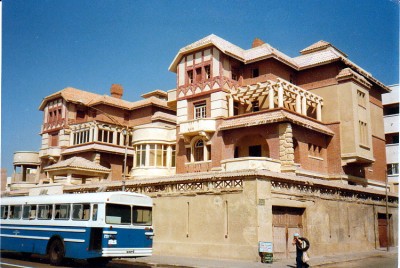
I understand these buildings have been razed and replaced with high-rise apartment blocks. No wonder: they fronted directly on the Cornishe, and the Mediterranean Sea:
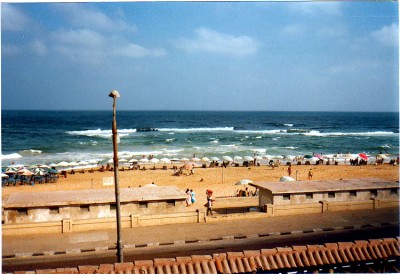
In those days (and I have no reason to think it has changed), Alexandria was almost deserted during the winter months, when the weather could indeed be rather raw as it blew in directly from the Med. In the summertime, however, the city became home to millions of Cairenes who came to Alex to escape the summer heat of Cairo. Then, the beach might look more like this:

The water along the beach was frequently polluted by sewage dumped directly, so swimming was not a very safe thing to do, and I rarely did it. You cannot see in pictures like this that women, if they came to the beach at all, did little more than wade fully dressed: swimming as such was reserved for the men. I found it amusing that guys wore bathing suits, usually quite revealing speedos, so long as they were ON the beach, but to go inland only so far as to buy a drink or ice-cream, they would dress first. Those dressing-rooms were often good places to catch guys changing.
Note the blue bus in the first photo: this is one of a fleet given to Alexandria by USAID: the busses were built in the USA, and were so shoddy that within a few months of arrival, all were finished. The APTA (Alexandria Passenger Transit Authority) had sent operatives to the US factory to explain the conditions of use the busses would be subjected to, but when these guys were ignored, they came home disgusted. What no one in the US could comprehend was that busses in Alex routinely ran at 200% capacity on poorly maintained streets and roads. So, the first time one of these went over a bump with 70 people hanging on the over-head hand-rails, (which had been pop-riveted in place), the rails pulled loose and were chucked out. The doors fell off soon thereafter. These were only slightly glorified school-busses (the company that built them had never built anything else). All this gave the US a major black-eye, and APTA went back to buying busses from France, as they had done for years.
Alexandria had a few antiquities left. It was the site of the famous Alexandria Library, nothing recognizable of which remained.
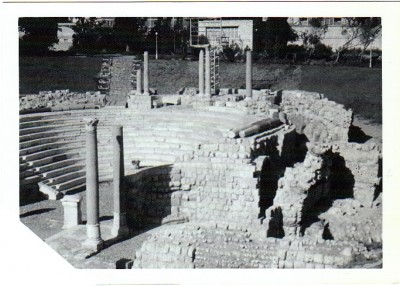
Alexandria did have a large fleet of derelict street-cars, most of them still running (more or less). Many had been purchased in Belgium. I rode them endlessly, as they were a real hoot!
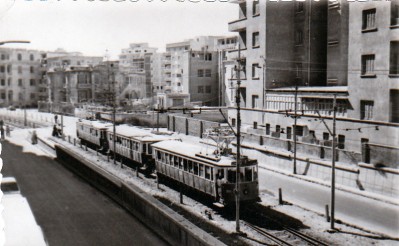 A train of three ex-Belgium trams MUed
A train of three ex-Belgium trams MUed
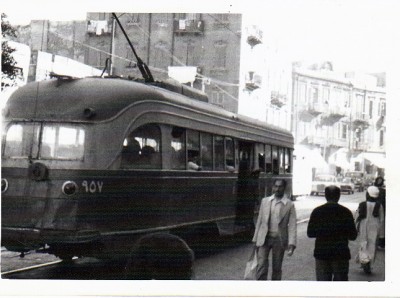 There were also PCC cars (ex-Toronto, Canada) which ran both singly and in trains of three
There were also PCC cars (ex-Toronto, Canada) which ran both singly and in trains of three
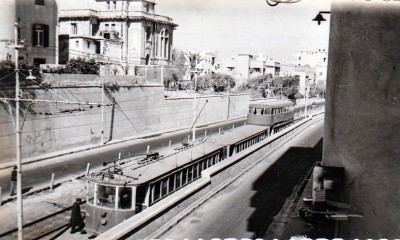 Here’s another three-car trainset ex-Belgium, the last car of which is a double-decker
Here’s another three-car trainset ex-Belgium, the last car of which is a double-decker
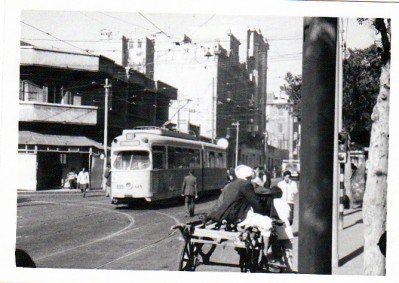 There were also old narrow LRVs from Belgium, which ran around the very old part of Alexandria, seen here at Orabi Square
There were also old narrow LRVs from Belgium, which ran around the very old part of Alexandria, seen here at Orabi Square
There was not a lot of gay sex going on in Alexandria. I eventually connected with a couple of guys from Luxor. They were pretty tight, but whether they were lovers as we would know the term I never was quite sure. But I enjoyed them both quite often. Ahmed’s friend was one of the prettiest Egyptians I met: for the most part, I was not particular taken with Egyptian men, who tended to treat me as they would a woman, quite brutally.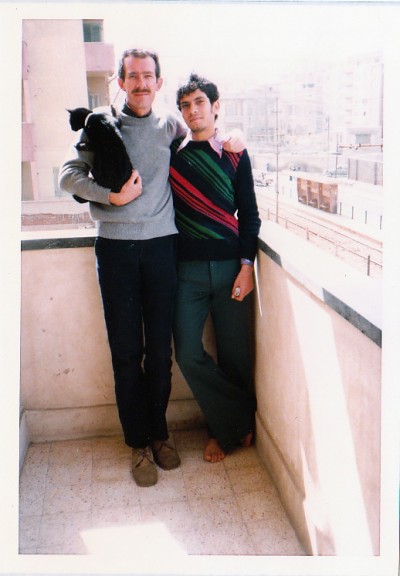
That’s me with my cat, Soda (which means “black” in Arabic) and Ahmed.
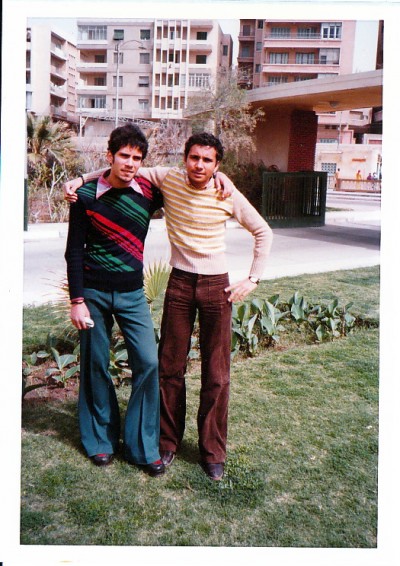 Ahmed’s friend was a real charmer! He knew how to dress to show off his tight bod.
Ahmed’s friend was a real charmer! He knew how to dress to show off his tight bod.
Alexandria had also taken delivery of some brand new Japanese trainsets. These were fitted with pantographs, but the overhead system had not yet been properly fitted for them. When these cars rocked far enough to one side (on the uneven rails) a pantograph could swing past the hot-wire and entangle the hangers, with predictable results: damage and delays. I took the series of pictures below from the verandah of my apartment, and managed to snap photos when the inevitable happened: they got something mixed up with the 600-Volt line, with spectacular results!
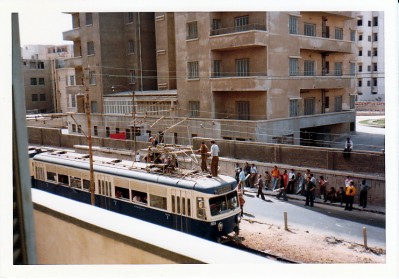
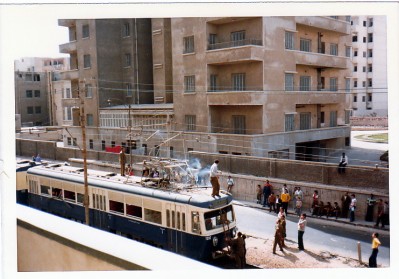
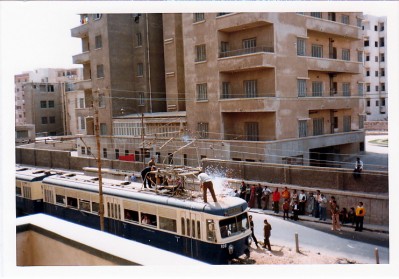 As you can see, the “fireworks” drew quite a crowd!
As you can see, the “fireworks” drew quite a crowd!
Sooner or later the line-car and crew had to be called out to repair the damage:
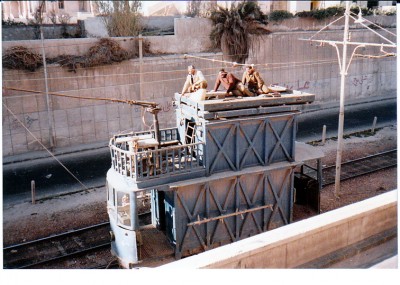 Rebuilt from an old Belgian tram.
Rebuilt from an old Belgian tram.
Then, early one morning, an early out-bound passenger tram collided with the line-car!
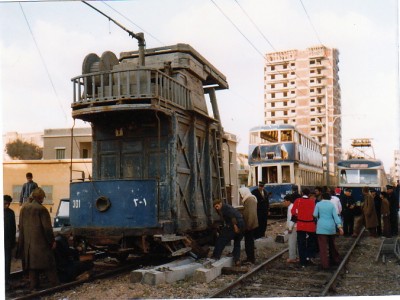
Trying to re-rail the line-car. Note caved-in front of car behind
In this old B&W photo, I am one of the “Four Musketeers”. Alas, only two of us are still alive.
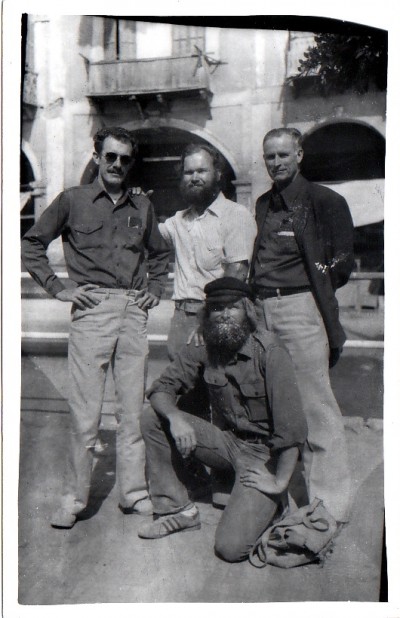
The Four Musketeers
There you have a bit of life in Alexandria. Here’s another: this image has been seen all over the world, but I actually saw this happen many times!
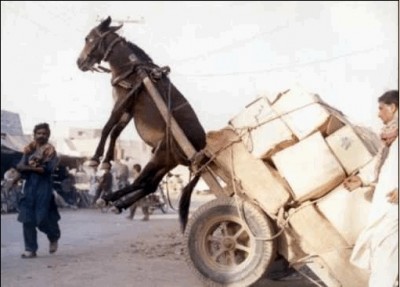
Slightly overloaded!
I’ll describe some of my trips around Egypt in future pages.

NEXT
RETURN TO CAIRO

Cairo is located at the start of the Nile Delta
My three months in Ecuador passed quickly. I was always busy, either tramping around on horse-back in the mountains, or riding the G&Q (and the Cuenca branch, in a rail-bus), or carrying-on in El Ejido park. The work turned out to be entirely for nought: when the seismic team arrived in Ecuador, shortly after I departed, they took a look at plans and exclaimed, “You’re going to put a dam on the Boca and create a reservoir at the foot of an active volcano? You’re out of your minds!” The plan was scrapped in its entirety, and other sources of water were found for Quito.
One thing amused me: I had been studying Arabic while in Alexandria and Cairo, then suddenly found myself surrounded by Spanish. In Arabic, the meaning of any word is conveyed by its consonants: vowels are just connectives and can generally be “whatever works”. But in Spanish, vowels are vitally important! Soon after arriving in Quito, someone was describing some fracaso in which his brother had become embroiled. I intended to say, “Que pena” (how sad, what a pity…). But I came out with “Que pene”, which literally means “What a penis!” This broke up everyone within earshot. I decided (knowing I would return to Egypt) to learn Spanish on another trip!
I spent another year in Cairo, and generally found it quite dull. When I needed some “action”, I took the train to Aswan and spent my excess per diem on the local fellows. I was on a felucca with several of them the night that Anwar Sadat spoke to the Knesset: all agreed this was a good thing for him to do, but of course Sadat was too close to being a true statesman, so he had to be eliminated: this occurred shortly after I left Egypt for good.
My last assignment in Cairo involved working seven days a week for nearly four months. This wore me down, and when it came time to depart, I had planned to fly to Nairobi and take the train to Mombasa, just as a recreational trip. At the last minute I decided I was too tired to even enjoy that, and a Filipino engineer working with us suggested I go to Manila instead. Since I knew a couple who were working there, I sent off a letter to them and re-routed myself to Manila, via Athens, Bangkok, and Bombay, arriving late afternoon at the old Manila International Airport. The place was thronged with people, among which there was no sign of my friends. A taxi-driver found me a place for the night—a brothel, as it turned out—but I was exhausted, so that didn’t matter. I found a nice hotel the next day and called my friends, who were astonished to hear from me: my letter would arrive a week after I did!
It did not take me long to decide I had died and gone to heaven: there were more gorgeous boys per square unit-area in Manila than in any place I had been, and I looked forward to sampling as many as I could. But that is for another page. Meanwhile, here are just a few photos taken in and around Cairo. Most of the time there I was too busy to take many pictures, and Cairo is not really a photogenic place.
 As long as you were far enough from it to be able to ignore the “floaters”, the Nile was quite beautiful. The floaters included entire dead animals and all sorts of other flotsam!
As long as you were far enough from it to be able to ignore the “floaters”, the Nile was quite beautiful. The floaters included entire dead animals and all sorts of other flotsam!
 Cairo traffic was horrendous. You’ve heard of the “horny Arabs”? The only traffic rule was to sound the horn as often as possible!
Cairo traffic was horrendous. You’ve heard of the “horny Arabs”? The only traffic rule was to sound the horn as often as possible!
 Another view of Cairo’s traffic problem. Too many cars, too many pedestrians, too many everything!
Another view of Cairo’s traffic problem. Too many cars, too many pedestrians, too many everything!
 The train-sets in use at the time had been built in Japan: maintenance was scarce and riders were plentiful, including chaps seen here clinging to the rear of a moving train.
The train-sets in use at the time had been built in Japan: maintenance was scarce and riders were plentiful, including chaps seen here clinging to the rear of a moving train.
 Taken from some high spot, this panorama covers about a third of greater Cairo; the estimated population then was 13 million, but no one really knew how many people lived there.
Taken from some high spot, this panorama covers about a third of greater Cairo; the estimated population then was 13 million, but no one really knew how many people lived there.
 This ebonet allowed me to ride Cairo busses without having to speak a destination. I rode them a lot, but only during “off-peak” hours, when they were actually quite handy and fast.
This ebonet allowed me to ride Cairo busses without having to speak a destination. I rode them a lot, but only during “off-peak” hours, when they were actually quite handy and fast.
 This beat-up freight train was photographed on the outskirts of Cairo.
This beat-up freight train was photographed on the outskirts of Cairo.
 A view of the Sphinx and Cheops Pyramid at Gizeh. I spent many hours trying to imagine building these monuments. To this day, no one is certain how it was done.
A view of the Sphinx and Cheops Pyramid at Gizeh. I spent many hours trying to imagine building these monuments. To this day, no one is certain how it was done.
 My Egyptian Driver’s License.
My Egyptian Driver’s License.
 This derelict old palace in Cairo attracted my attention: I thought it would be fun to restore it. I doubt it has survived.
This derelict old palace in Cairo attracted my attention: I thought it would be fun to restore it. I doubt it has survived.
 The “Gang of Four” at the Sphinx. Of these, I am the only one still living.
The “Gang of Four” at the Sphinx. Of these, I am the only one still living.
 The main road to Gizeh, and to the Desert Highway to Alexandria, about 230 km distant.
The main road to Gizeh, and to the Desert Highway to Alexandria, about 230 km distant.
Friends who have been back to Cairo say it is a much-changed place since I left it in 1982. So be it: I have no interest in returning there! Especially after spending time in Manila, which quickly became my favorite place in the world (even though there were no steam trains there). I’ll see if I have any photos from Manila to include on my next page. There may not be any!

NEXT
THE PORN REVOLUTION
I INTERRUPT MY NARRATIVE …
… to discuss a matter of some importance to several large segments of our population: pornography.
I’m old enough to remember vividly the days when there was NO commercial porn. What porn there was consisted mostly of typewritten material, often second-and third- carbon-copies, occasionally with crude drawings included. A friend of mine had a HUGE collection of this stuff. Later, when the firm for which we both worked got a dry copier, he made Xerox copies in large quantities. Since he was the “key operator” for the machine, he got away with it for many months, until he left an “original” on the platen which someone else found. There was a bit of a dust-up, of course, but only a very few knew he was the perp, so he went on with it, being more careful! But I digress…
As I completed college, I found there were some magazines available here and there: these were not really pornographic in today’s sense of the word. There were no “dirty-book stores”: only a few magazine-stands would carry these off-color rags. One of these was a tiny (like, 5″ X 7″) black and white booklet called Tomorrow’s Man. It was mainly devoted to body-builders, posing (often oiled) in miniscule thongs and jock-straps. Penises were generally stuffed out of the way, which gave rise to the notion that most body-builders are not well hung. (The porn revolution has busted that myth!) Fizeek was another of these magazines, very similar in design and scope and there were several others.
Then there was AMG (Athletic Model Guild), in a slightly larger format, also black and white. This was produced in Southern California and appeared to contain mostly navy guys (”seafood”) earning a little extra cash (to buy booze and girls, of course). I suppose a collection of these magazines would be worth some money nowadays. In the early issues the boys were mostly dressed, usually shirtless, and showing some basket (sometimes enormous ones—I often suspected salamis had been substituted for the real thing). The intent of these photos was certainly to provoke a salacious reaction in the reader, and I suppose it was successful for some: but the other intent was to “push the envelope” and get porn main-streamed. As time went on, the guys wore less and less and various symbols (often scratched on the negatives) were used to indicate sexual preferences, physical statistics and so forth. It is difficult, now, to believe that to state (or even suggest) that someone was “gay” or -gasp- homosekshull, was forbidden! [When someone implied Liberace was homosexual, he sued (libel), and WON!] The cute stuff in AMG was all designed to avoid prosecution for distributing “obscene” material under a whole bunch of court rulings generally lumped together and called “obscenity laws”
TM eventually disappeared (a copy from 1954 was available recently for $95.00), but AMG pushed on pushing, their material becoming more prurient and occasionally in color. Then, in 1973, came “Miller v. California”, which, while not opening the flood-gates exactly, did make it obvious the definition of obscene was not an easy task. It gradually dawned on people in general and on the courts, that obscenity was as much “in the eye of the beholder” as in the producer: by this time, AMG was definitely obscene, and was to become far more-so before it folded.
However, from the 70’s on, pornography “took off”. Large-format magazines that had kept the air-brushes busy removing “lumps” began including explicit (and occasionally real) hard-ons: the air-brushes went to work enhancing rather that deleting! With the useful addition of “adult” bookstores where all this stuff could be displayed and sold, the pornography market exploded. Specialty-subject mags appeared, including kiddie-porn, which as quickly as it appeared was legislated out of existence. My favorite title of the “niche rags” was Stump, and I leave it to my readers to imagine its contents!
Professional pornographers were quick to exploit technology: even amateurs quickly saw the possibilities of the Polaroid camera! I had a neighbor in the early 50’s who took photos of every hard-on he could find (he’s immortalized in Piece on Earth at Nifty). Prior to that, all porno had been produced on conventional film, an expensive and laborious process given that one had to find places to develop film that would NOT call the cops if they found a hard-on (or worse). The advent of the electronic camera for production (professional and otherwise), and the internet (for distribution) has radically changed the whole “porno” scene. Kids growing up today have this phenomenal wealth of porn available if they want it, and the ready means to produce and distribute it themselves if so inclined: and they do, as I’m sure my readers know.
It’s all pretty amazing stuff for old farts like me who have watched it all unfold. My own career, such as it is, writing “fuck stories” began in 1987 with First and Second Cousins: it has been on Nifty practically from its inception.
PeeYes: I’m also old enough to remember that the Nifty (gay) Archive was originally accumulated by someone at Cornell University: whether student or faculty I’ve never known. Its original URL ended in cornell.edu! I suppose someone eventually discovered it and forced it off-site! But it still exists here and contains thousands of original gay stories; many are fine examples of “one-handed-reading”.

NEXT
ASCENDING THE ANDES BEHIND STEAM
Let’s take a ride behind steam on the G&Q!
I’ve already covered the part from Durán to Bucay, so will only repeat a bit of that here. But the real fun starts in Bucay, where average grades run between 4 and 5%. Even getting the train under way at Bucay is not easy, as the rails are on a curve at several percent grade!
Here we go:

Here’s your ticket!

Work gets under way early. Engines may have to be fired up from cold, or brought up to pressure if a night-hostler has kept them warm.

Number 11 will take us to Bucay today. This little Atlantic is only 68 years old! Her fire is little balky, lacking a good draft.

The train has been made up, and number 11 struggles to get traction on the wet rails as it pulls the train into the station.

Note the lack of a fireman: the engine was just being moved down to its train, so the night-hostler did the needful.

As we pull out of Durán, we pass several old engines, but the one at right is Number 58, the last engine to come to the G&Q from Baldwin, and one of the last Baldwins built.

We have arrived at the southern end of Bucay. Here the train brakes will be set, and number 11 will enter the yard for a well earned rest and drink of water. She will take a small freight consist back to Durán. Number 46 awaits us and will back down to pull our train on up to Bucay Station.

At 33 years of age, Number 46 is a youngster compared with Number 11! This Consolidation will take us on up to Alausí.

Meanwhile, Number 17 is being fired up to take a freight extra down to Durán.

Number 11, rested and watered, backs to her train back to Durán.

And Number 17 moves back to her train, a freight running extra.

After thorough oiling and turning on the wye, Number 46 will back down to replace Number 11 at the head of our train.

Under way briefly, we are pulled up into Bucay town and station, right up the main (and pretty much only) street in town.

We approach the station at Bucay. Here we will wait for some problems to be corrected.

Derailments are not uncommon, as most of the ties are rotten in the ground. Spreading a rail is all too easy.

One of our group wanted to ride this little chair-car, but he was chased off: the car was reserved for a big-wig of the railroad!

Here is the business end of Engine 46.

Pretty simple, really!

Looking back as we depart Bucay with many passengers on the roof of the boxcar.

We cross the Rio Chan Chan immediately as we depart Bucay. We will cross it many times!

Further on we pass a diesel engine and a steam engine in the hole for us.

The rails look more like a foot-path, but we will pass over them momentarily.

We soon cross the ChanChan again. Note the still-lush flora; it is not quite so tropical here as down in the flats. Before we reach Alausí we will reach past the treeline.

That’s the ChanChan in the foreground, and another bridge over it in the distance. We are getting into the hills now.

Approaching that bridge over the ChanChan.

The Rio ChanChan has gone on numerous rampages over the years, so this section of the railroad has been rebuilt repeatedly. That’s our way forward above the water-line.

There are several tunnels. Riding on the tender of a locomotive is not the best place to be when going through, but fortunately, there was light at the other end.

Get your partners for the tunnel! Better yet, put a shirt over your head and stop breathing!

The mechanista often has a tough time when the rails are wet and slippery. But sometimes it is a family affair!

We are entering a canyon, and will soon reach Sibambe. The Cuenca branch of the railroad can be seen coming down the hillside.

It’s worth looking back whence we’ve come once in a while!

Onward and upward! the Engineer has one hand on the throttle and the other on the brakes as the engine works. The Fireman is alert to whatever is ahead, and maintains the fire. He also sees to it water is fed into the boiler as fast as it is used up.

It is necessary to sand the flues often. Bunker C oil burns badly and makes a lot of soot that reduces the rate of heat transfer from the fire to the boiler tubes. Sand passing through knocks off the soot, and also rains down on whoever might be sitting on the tender. Like me!

There are numerous water-stops along the way. Working on heavy grades, these little engines boil a lot of water!

The Engineer keeps a sharp eye out for rock-slides and other hazards.

There is our first glimpse of the Nariz del Diablo: the Devil’s Nose.

Still working hard! Sibambe is not far around the next corner, and the Cuenca branch comes down from the right.

The two cuts comprising the switch-back on the Devil’s Nose can be seen clearly. Our little train will be up there fairly soon!

Looking up from Sibambe at an autoferro ascending the Devil’s Nose.

Our train takes water again and has bit of a rest at Sibambe.

The station at Sibambe.

We depart Sibambe. The train will go as far as it ever did up the canyon of the Rio ChanChan.

The Canyon walls close in as we struggle upwards.

We encounter a train in Huigra pulled by S&C Number 18.

We depart Huigra. From here it is not far to end of line. (Except for the switch-back, that is).

Approaching the first switch. Once clear of it, we will back up on the track seen at right.

Our train has cleared the switch, and will now back up on the track curving left.

We back up around the Devil’s nose. The Engineer cannot see the end of his train, and has to take it on faith that his train remains on the track! Of course, there are numerous brakemen who keep watch as well.

When our engine clears this switch, it will be thrown to put us on the forward leg of the switch-back.

We approach the reversing switch. The rest of the train is out of sight around the curvature of the Devil’s nose.

The Engineer seems bored. I suppose it was all in a day’s work for them, but it was exciting for me!

This is the view looking back down to Sibambe!

We have pulled ahead on the upper track and are headed for Alausí. Note how the flora has changed! We are still on the Devil’s Nose here.

We are just about off the Devil’s nose itself. Our train is perched delicately on this rocky ledge.

We are off the Devil’s Nose. Alausí is not far ahead.

That’s our line ahead. The ChanChan is now far below us. We will be in clouds before long!

Number 51 resting at Alausí. She’s dead-heading down hill after helping a freight up the hill seen beyond the town. That way lies Riobamba, but in 1979 only the Diesel electrics were making that run.
That’s my tale of a trip up the Andes behind steam. Sharp eyes will note that several engines are used in this excursion, which is really a compilation of several such runs at various times. I rode the G&Q every chance I got, and on some days made the ascent from Bucay to Alausí several times. It was more fun than a barrel of monkeys, as the old saying goes, and many years later I returned to ride again, by which time the railroad was pretty far gone. I’ll cover that in my narrative later on. Meanwhile, before returning to Cairo, I will put up one more page of miscellaneous sights on the G&Q.

NEXT
UPDATE NUMBER 2
I seem to be losing readers. This is not surprising, since the blog is only being updated sporadically.

Thanks to StatCounter
But, never mind.
We recently had occasion to entertain a group of architects who were interested in my house. I though it would be fun to have the dining table set up as if the owner (when the house was built) was going to entertain the President of the US (when the house was built). The guests were, therefor, Mr. and Mrs. John Coop, and President and Mrs. Grover Cleveland. We fashioned a typical Victorian table-setting with all the finery we could muster. The results are shown below:

An over all view, with the gas lights lit

A closer look. The table-cloth is Thai silk

Coffee service and Cognac at the ready
The “menu” was developed from period sources and I thought it would be quite awful if ever actually prepared. Terrapin was included only because I happen to have the terrapin forks (which I have never used).

Appropriate vegetables included for each remove
All quite vomitous, I think!
That’s all, until next time!
